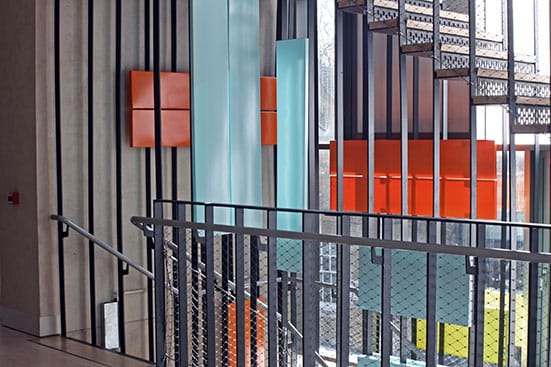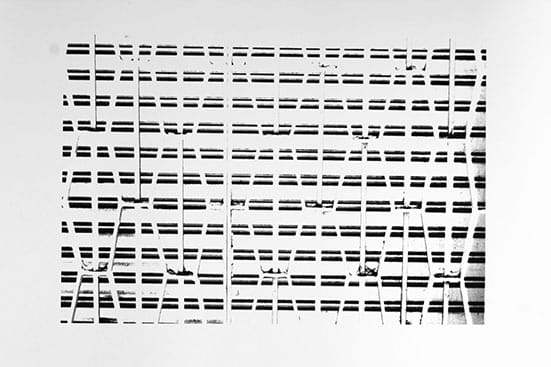Could you tell me about the relationship of your new work to the design, architecture and activities of the Siobhan Davies Studios?
I found the architecture completely dominating when I first visited the space and when I was considering how to approach a show there it was an unavoidable element that I could not ignore.
I really got the sense that a lot of thought had gone into creating a particular atmosphere and in designing the nooks and crannies that exist there and so, it just felt apparent that whatever I did needed to address or work with the existing design within the space.
I like the fact that things in the building are slowly revealed in time and I like the fact that there are things that make you look twice, that you didn’t notice before or which you suddenly see in a different way. The building is full of this.
What is the significance of the exhibition title?
It relates to the idea of double vision in the sense of ‘round circles’ being tautological and essentially defining the same thing twice. Repetition is something encountered throughout the space and the artworks. Some of the works are sculptures but could be thought of as props. I was also thinking about movement and the experience of planned, designed spaces as well as marking or defining spatial boundaries.
Do you enjoy working site-specifically?
In this context I enjoyed pulling my ideas together to work with an outside element, it felt almost collaborative. It also gave me an opportunity to try a few things out. The placement and positioning of the work I make is always an important thing for me. Whether or not the work was made to fit the space, I like to think about how our bodies will navigate it and how movement can join the individual pieces together and give them a sense of structure.
What is your usual working method?
I don’t think I have a set method. There are always various ideas or themes that I am constantly thinking of. I see all the works in the show as more of an interwoven set of connections that come from an accumulation of various ideas, thoughts and links even if some of the work is made quite obviously with the space in mind.
In terms of this particular show, before making anything, I spent a bit of time in the space, just to watch how it was used. The time there made me very aware of its details and the careful compositional balance within the building. The longer I was there, the more layers of these elements were revealed and so I naturally became more aware of certain parts of it. I noticed the careful selection in the design of its surface textures and details; the staircase contains this real sense of gravity and weight as it wobbles and moves as you walk up and down it and then there is also a feeling of time as the light and shadows travel through its beams.
I wasn’t really interested in placing objects in the space that were disconnected from this because such an act felt far too jarring; what was most interesting for me was to make a work that fitted into the space and functioned as more of a counterpart of the design – so finding a way of working with it in somehow.
You have left your metal works untreated so they will tarnish gradually.
Is the passage of time an integral part of your work?
It’s definitely something that I became very aware of when working in the studios. I am interested in the possible ways that movement and time come together and how they can influence a sense of where we are or a way of looking.
How does your sculptural practice relate to choreography?
Both in terms of movement around objects in space and also their positioning within it. When I decide where to place work it is always installed in response to the immediate physical environment, so, I think about the form of the work against the surfaces around it and how we may react when we walk around or through artwork placed in it. I might think about the different viewpoints we can enter with into a work compared to those when we leave it, or how it forces us to move around it in a certain way.
How do you intend your audience to interact with works such as barre, which is based on a Merce Cunningham prop and is slightly unstable?
I specifically didn’t want to treat the works in a precious way and wanted to blur the understanding of it being a sculpture or a prop or something set aside for later use. I suppose it’s confusing which one of these it is but I like the idea of encouraging a dialogue of what these objects are with the relationship of the way the building is being used by the audience and everyday dancers.
Those works are just things and there is nothing reverential about them and so in this context I don’t mind if they are accidentally interacted with or mistaken for. I was thinking about what the act of reproducing an object does to change it and it’s function, as in the case of the vacuum formed sound-proof panels who lose their original purpose.
Some of the works in the exhibition were made in Burma/ Myanmar.
How was your experience of visiting and making work in this isolated country?
It was unexpected and fascinating, I went there to look at the heritage buildings and how people lived their lives amongst these spaces and I spent a large part of my time documenting the shop front grilles and looking at these patterned structures that divide boundaries in space. The outcome series of prints reflected a past interest in the double interpretation of an image by playing with the familiar and recurrent forms in our environment.
What is your next project?
I am currently trying to spend as much time as I can in the studio working through a lot of the impressions I made in Burma, There is a lot of material in there and from elsewhere that I would like to expand on and attempt to incorporate into my practice somehow. I am also doing research on housing estates built in Camden from the 60s & 70s.
Ali MacGilp

Lilah Fowler, Panelling, installation view at Siobhan Davies Studios

Lilah Fowler, Hoops, installation view at Siobhan Davies Studios

Lilah Fowler, Barre, installation view at Siobhan Davies Studios

Lilah Fowler , Grille #2